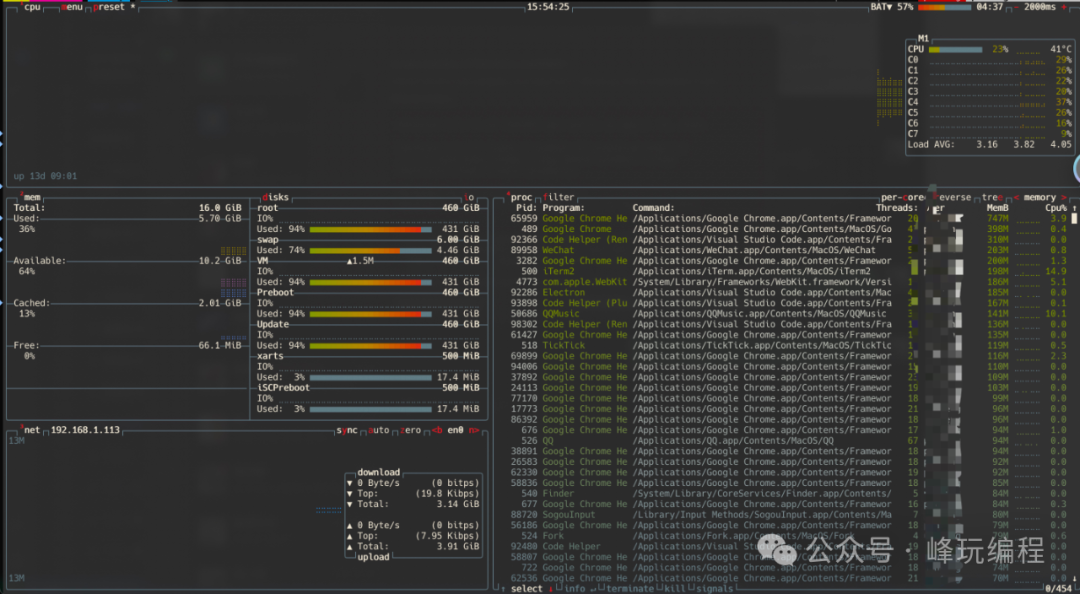Introduction
<span><span>btop</span></span> is a modern terminal-based system resource monitor that features an attractive graphical interface, quick responsiveness, and rich functionality. It supports viewing <span><span>CPU</span></span>, memory, disk, network, and processes, and allows for easy filtering and management of processes.
Feature Overview
Startup command:
btop
The interface is divided into the following sections:
-
CPU Area: Displays usage rate, frequency, temperature, etc., for each core
-
Memory Area: Displays total memory, cache,
<span><span>swap</span></span>, and current usage rate -
Disk Area: Read and write speeds, usage rates for each device or mount point
-
Network Area: Displays the send/receive rates of each network card,
<span><span>IP</span></span>, data volume, etc. -
Process Area: Displays active processes, supports sorting, searching, and termination

Keyboard Shortcuts
-
<span><span>ESC</span></span>: Open/close the settings menu -
<span><span>m</span></span>: Toggle memory display units (KB/MB/GB) -
<span><span>e</span></span>: Expand/collapse the process tree (default is tiled) -
<span><span>f</span></span>: Search for process names (real-time filtering) -
<span><span>↑ / ↓</span></span>: Move the process cursor up/down -
<span><span>← / →</span></span>: Move horizontally to different modules (CPU/memory/disk) -
<span><span>Enter</span></span>: Enter the settings menu or confirm -
<span><span>k</span></span>:<span><span>kill</span></span>the selected process (send default<span><span>SIGTERM</span></span>) -
<span><span>z</span></span>: Display detailed process information (similar to<span><span>top</span></span>details) -
<span><span>q</span></span>: Exit<span><span>btop</span></span> -
<span><span>s</span></span>: Modify the process sorting method
Settings Menu (Press ESC to enter)
-
Theme
-
Enable graphical animations
-
Update frequency
-
Default sorting method
-
Expand process tree on startup
-
Enable Swap display, etc.
Process Management Features
-
Select a process using
<span><span>↑ / ↓</span></span> -
Press k to terminate (
<span><span>kill</span></span>) it (send SIGTERM) -
Use z to view detailed status of the process (e.g., CPU time, thread count, etc.)
-
Search for processes (press f, enter keywords to filter)
Configuration File Location
~/.config/btop/btop.conf
Theme Switching
View themes
ls /usr/share/btop/themes/
Switch method:
btop --theme monokai
Setting Sorting
Method 1: Use UI Settings
-
In the
<span><span>btop</span></span>main interface, press<span><span>Esc</span></span>to enter the settings menu -
Use the arrow keys to move to “Options” or “Process options”
-
Find the
<span><span>Process sorting</span></span>option -
Press
<span><span>← / →</span></span>to toggle, supported options include: <span><span>cpu</span></span>: Sort by CPU usage<span><span>mem</span></span>: Sort by memory usage<span><span>pid</span></span>: Sort by process ID<span><span>time</span></span>: Sort by running time<span><span>user</span></span>: Sort by user-
After setting, press
<span><span>Esc</span></span>to exit the settings interface to take effect
Method 2: Modify Configuration File
vim ~/.config/btop/btop.conf
Find the following configuration line:
proc_sorting="cpu"
Replace <span><span>cpu</span></span> with the desired sorting method, such as <span><span>mem, pid, user</span></span>, etc., and then save.
Method 3: Directly switch sorting method in the process area using arrow keys
Common Options
-
<span><span>--theme <name></span></span>: Use specified theme at startup -
<span><span>--utf-force</span></span>: Force use of UTF8 graphics -
<span><span>--no-update</span></span>: Do not automatically check for updates -
<span><span>--help</span></span>: View help information
Comparison with Other Tools
| Tool | Advantages | Disadvantages |
|---|---|---|
<span><span>top</span></span> |
System built-in, most lightweight | Interface is unattractive, limited information |
<span><span>htop</span></span> |
Interactive, slightly better interface | Does not support disk/network display |
<span><span>btop</span></span> |
Cool graphical interface, comprehensive features, easy to use | Uses slightly more resources (for graphical rendering) |